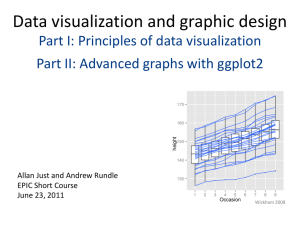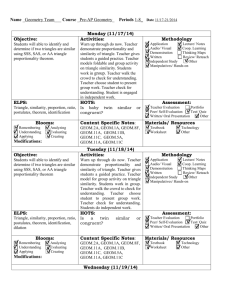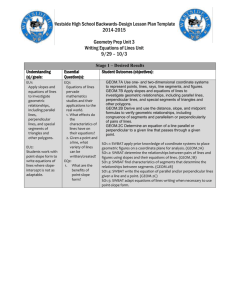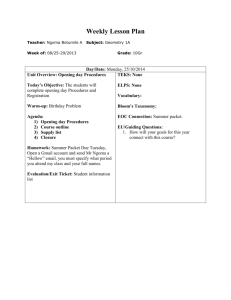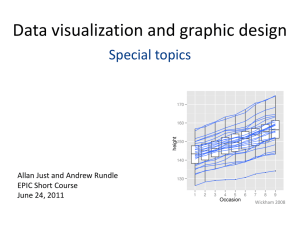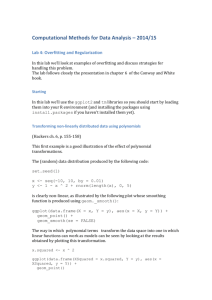Computational example - Electrical & Computer Engineering
advertisement
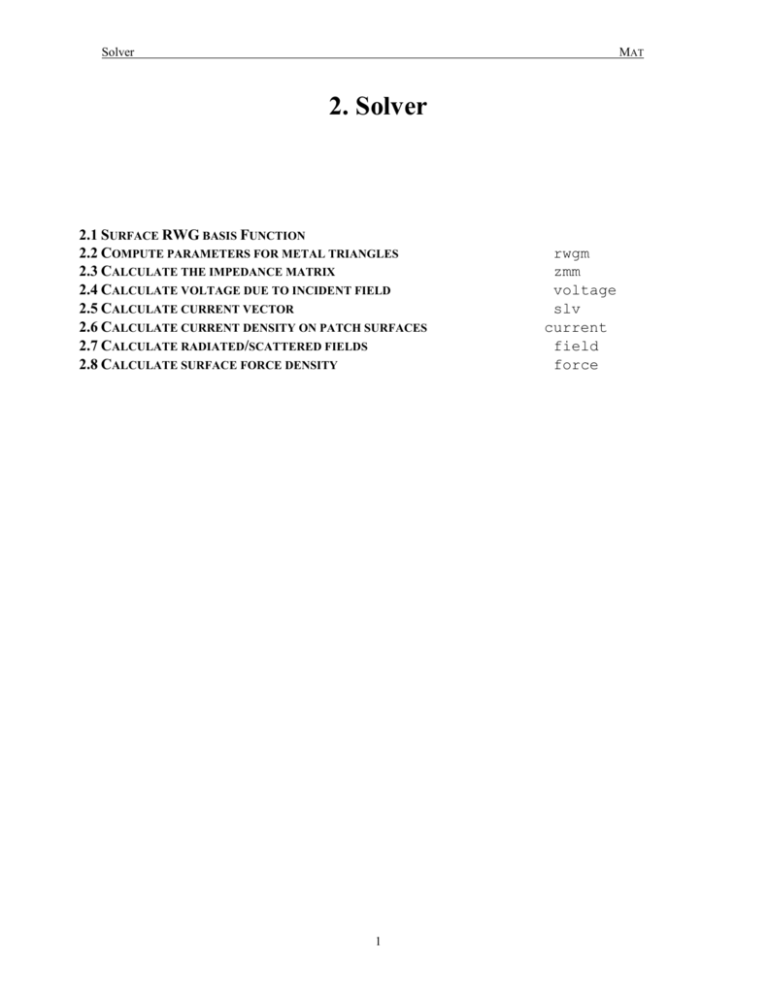
Solver MAT 2. Solver 2.1 SURFACE RWG BASIS FUNCTION 2.2 COMPUTE PARAMETERS FOR METAL TRIANGLES 2.3 CALCULATE THE IMPEDANCE MATRIX 2.4 CALCULATE VOLTAGE DUE TO INCIDENT FIELD 2.5 CALCULATE CURRENT VECTOR 2.6 CALCULATE CURRENT DENSITY ON PATCH SURFACES 2.7 CALCULATE RADIATED/SCATTERED FIELDS 2.8 CALCULATE SURFACE FORCE DENSITY 1 rwgm zmm voltage slv current field force Solver MAT 2.1 SURFACE RWG BASIS FUNCTIONS In this section we discuss the surface RWG basis functions used for modeling the metal surface and the Method of Moment solution. The metal surface is divided into triangular patches as shown in Fig.1 Fig.1 Surface RWG basis function For any two triangular patches, t n and t n , having areas An and An , respectively, and sharing the common edge l n , the nth basis function is defined as ln S 2 A f n (r ) n l n 2 An n r in t n r in t n n (1) where n r rn is the vector drawn from free vertex of triangle t n to the observation point; n rn r is the vector drawn from the observation point to the free vertex of triangle t n . The basis function is zero outside two adjacent triangles t n and t n . 2 Solver MAT 2.2 COMPUTE PARAMETERS FOR METAL TRIANGLE rwgm Computes parameters for metal triangles including self-integrals. Syntax: [geom]= rwgm (P, t, IndexF) Description: The function rwgm returns a structure geom which defines all the parameters of the metal triangles including self integrals. The self integrals for metal are calculated using the functions analytma and analytmb The input parameters to the function are IndexF which defines the number of integration points and the P and t matrices which correspond to the vertices of the triangles and their x, y and z coordinates respectively for a given structure. The structure geom includes the following parameters. geom.EdgesTotal geom.TrianglesTotal geom.EdgeLength geom.PointsFC geom.TriP geom.TriM geom.VerP geom.VerM geom.AreaF geom.SizeF geom.IndexF geom.PointsF Integer Integer [1,EdgesTotal] [3,TrianglesTotal] [1,EdgesTotal] [1,EdgesTotal] [1,EdgesTotal] [1,EdgesTotal] [1,TrianglesTotal] [1,TrianglesTotal] Integer [3,TrianglesTotal*IndexF] geom.PointsFRho [3,IndexF,3,TrianglesTotal] geom.PointsFCRho [3,3,TrianglesTotal] geom.W [1,IndexF] geom.MM00 geom.MM01 geom.MM1 [1,TrianglesTotal] [1,TrianglesTotal] [3,3,TrianglesTotal] geom.MM2 [3,3,TrianglesTotal] r self-integral i j without V 2 geom.MM3 [3,3,TrianglesTotal] self-integral i j r without V 2 geom.P [3,TrianglesTotal] geom.t [4,TrianglesTotal] Coordinates of the triangles Vertices of triangles 3 Total edges in the structure Total triangles in the structure Length of edge Coordinates of center of metal faces Index on plus triangle Index on minus triangle Free vertex of plus triangle Free vertex of minus triangle Area of faces Effective triangle size Order of integration for faces Integration points of the Gaussian formulae Vector drawn from the free vertex to the Gaussian points. Vector drawn from the free vertex to the center of the face. Weights of the points obtained during Gaussian subdivision self-integral 1/r without V 2 self-integral r without V 2 self-integral i j without V 2 vertices of Solver MAT 2.3 CALCULATE THE IMPEDANCE MATRIX zmm Computes the impedance matrix for pure metal structures. Syntax: z =zmm (geom, const, frequency) Description: The function zmm returns matrix ZMM [geom.Edgestotal, geom.Edgestotal] which corresponds to the impedance matrix for pure metal. The inputs to the function are two structures geom and const and the frequency of operation in Hz. The structure geom defines all the parameters of the metal triangles including self integrals which is obtained from rwgm while the structure const defines the electromagnetic constants such as 0 , 0 , c (speed of light in vacuum) etc. Theory: Z mn j 0 4 f mS (r ) f nS (r ) g (r , r )dr dr Sm Sn j 40 S f mS (r ) S f nS (r ) g (r , r )dr dr (2) Sm Sn where g exp( jkR) / R, R r r is the free-space Green’s function (time dependency exp( j t ) is assumed everywhere). 0 = absolute permeability of free space 0 = absolute permittivity of free space f nS (r ) is the basis function as explained in section 2.1 The detailed derivation of the impedance matrix in given in section A1 of Appendix A. 4 Solver MAT 2.4 CALCULATE THE VOLTAGE DUE TO INCIDENT FIELD voltage Computes the voltage vector for pure metal structures. Syntax: [V] =voltage (const, geom, frequency) Description: The function voltage returns vector V [1, geom.Edgestotal] which corresponds to the voltage vector for pure metal. The inputs to the function are two structures geom and const along with the frequency of operation. The structure geom defines all the parameters of the metal triangles including self integrals which is obtained from rwgm while the structure const defines the electromagnetic constants such as 0 , 0 , c (speed of light in vacuum) etc. Detailed explanation of the mathematical formulation is given in equations A9 and A10 of Appendix A. 5 Solver MAT 2.5 CALCULATE THE CURRENT VECTOR slv Computes the current vector. Syntax: I = slv (z, v); Description The function slv returns the current vector I [1, geom.EdgesTotal]. The inputs to the function are the two matrices z [geom.EdgesTotal, geom.EdgesTotal] obtained from zmm and v [1, geom.EdgesTotal] obtained from voltage. The function uses LAPACK function zsysv (zsysv_ for LINUX) for solving equations of the form [z][ I] = [v] where z is a complex symmetric matrix. See also: LAPACK and BLAS functions in MATLAB Help. 6 Solver MAT 2.6 CALCULATE THE CURRENT DENSITY ON PATCH SURFACE current Computes and display the current density for every surface patch Syntax: [Current_, Current] =current (geom, I) Description: The function current returns vectors Current_ [3, geom.TriangleTotal] which corresponds to current density for patch centroids and Current [3, total vertices of triangles in the structure] which corresponds to the current density for vertex points. The inputs to the function are the structures geom and current I. The structure geom defines all the parameters of the metal triangles including self integrals which are obtained from rwgm while the current I is obtained using slv from the z and v matrices. The surface current density, J S is expanded into basis function in the form N J S I n f nS (r ) (3) n 1 The theory is explained in detail along with the mathematical formulation in section A5 of the Appendix A. 7 Solver MAT 2.7 CALCULATE THE RADIATED /SCATTERED FIELDS AND POYNTING VECTOR. fields Computes radiated/scattered electric and magnetic field and the Poynting vector for radiated/scattered field. Syntax: [Poynting, E, H]=field (const, geom, I, frequency, Points, Option) Description: The function field returns vectors E [3, PointsS] Radiated/scattered electric field (complex vector at a point, V/m) H [3, PointsS] Radiated/scattered magnetic field (complex vector at a point, A/m) Poynting [3, PointsS] Poynting vector ( W / m 2 ) for radiated/scattered field where PointsS is the matrix of Points where the field is calculated The inputs to the function are two structures geom and const .The structure geom defines all the parameters of the metal triangles including self integrals which is obtained from rwgm while the structure const defines the electromagnetic constants such as 0 , 0 , c (speed of light in vacuum) etc. In addition to these, the other input parameters include the current I which is obtained using slv, frequency of operation in Hz, observation point where the field is to be measured and an additional parameter called Option. The value of option can be 0 or 1 depending on whether scattered field or total field is to be calculated. Option = 0 Calculates scattered field at a point Option = 1 Calculates total field at a point The theory is explained in detail along with the mathematical formulation in section A5 of the Appendix A. 8 Solver MAT 2.8 CALCULATE THE SURFACE FORCE DENSITY force Computes the force density for patch centroids and vertex points. Syntax: [Force_, Force] =force (geom., const, frequency, I, E, H, option) Description The function field returns vectors Force_ [3, geom.TriangleTotal] - surface force density for patch centroids Force [3, total vertices of triangles in the structure] surface force density for vertex points. The inputs to the function are two structures geom and const .The structure geom defines all the parameters of the metal triangles including self integrals which is obtained from rwgm while the structure const defines the electromagnetic constants such as 0 , 0 , c (speed of light in vacuum) etc. In addition to these, the other input parameters include the current I which is obtained using slv, frequency of operation in Hz, the electric and magnetic fields obtained using field and an additional parameter called option. The value of option can be 0 or 1 depending on whether full force or Lorentz force is to be calculated. option = 0 only Lorentz force F J B F J B E q option = 1 full force 9
